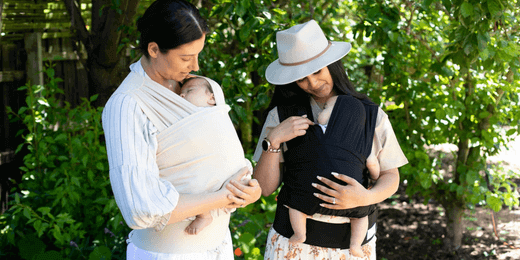Discover the benefits of swaddling with our guide. From how to swaddle a newborn, to transitioning from a swaddle, learning the different swaddling techniques and when to stop using swaddle blankets.
Swaddling is an honoured practice that has been shared across generations, providing newborns with a sense of comfort and security. It's a method that closely mimics the snug environment of the womb, which plays a vital role in promoting longer, more restful sleep for babies. For new parents, understanding and mastering this art can be an invaluable skill in your parenting journey.
For my own journey - in those first few weeks at home with my daughter El, I was completely smitten, and terrified all at once. I’d received approximately fifty thousand pieces of contradictory advice from the various midwives that interrupted our sleep, and now we were finally alone. I was excited to just snuggle and hold the newest edition to my life. But then came the swaddling. Was it arm under or arm up swaddle, did I tuck in or fold first? What did the tenth midwife say again? And why did she end up looking like a badly put together sausage roll whenever I attempted it by myself with the constant unraveling of the muslin swaddle! Feel me? So let’s cover off how to approach this beautiful art and help you feel like the confident Mama you deserve to.
Decoding the Art of Swaddling
Swaddling involves wrapping your baby tightly in a blanket, creating a secure and cosy environment that envelops the baby's body, from their chest to their feet. This soothing technique helps reduce the startle reflex in babies, a sudden movement that can often wake them up. By mimicking the womb's environment, swaddling helps soothe babies, providing a comforting space that promotes restful sleep.
Understanding Your Baby's Arms Movement and Swaddling Techniques
Observing your baby's arms movements can provide valuable insights into their comfort and preferences. Some babies prefer having their arms near their face, a position that can be accommodated with the Arms Up Swaddle technique, it's important to understand that this position holds a reassuring familiarity for them. This is because, while nestled in the womb, their tiny arms were often positioned near their face. This method involves leaving the baby's arms slightly bent and positioned near their face within the swaddle, providing them with a familiar and reassuring environment.
The Importance of Wrapping Your Baby's Body Correctly
When swaddling, it's crucial to wrap your baby's body correctly. The swaddle blanket should be snug but not too tight, allowing enough room for leg movement. This ensures your baby feels secure without restricting their mobility, promoting both comfort and healthy development.
Ensuring Comfort Around Your Baby's Chest Area
Paying close attention to how the swaddle fits around your baby's chest area is essential. The swaddle should fit snugly but not tightly, allowing your baby to breathe comfortably. If the swaddle is too tight around the chest, it can restrict your baby's breathing and cause discomfort.

*The image above showcases an example of an incorrectly swaddled newborn. Notice that the swaddle is too close to the baby's mouth and covers its head, which are both practices to avoid
Choosing the Perfect Swaddle Material
The market offers various types of swaddles, each designed to cater to different needs and preferences:-
Muslin Swaddles: These are lightweight and breathable swaddles made from woven cotton fabric. Ideal for warmer climates, they provide airflow, keeping your baby comfortable. However, the loose weave might sometimes allow the baby's legs and feet to slip out of the wrap, turning the muslin into a loose blanket.
-
Stretchy Swaddles: Crafted from a blend of cotton, spandex, or bamboo fabric, stretchy swaddles offer a secure wrap with some stretch. The elasticity of these swaddles allows for a custom fit, accommodating the baby's arm movement while still providing the snug feeling of being in the womb.
-
Swaddling Blankets: These versatile blankets, available in various materials like cotton, flannel, or fleece, offer multiple uses. Apart from swaddling, they can double as receiving blankets, nursing covers, or even a soft surface for tummy time.
-
Sleeping Bag: Designed for convenience, sleeping bags feature a two-way zipper that allows easy access for nighttime feeds and changes. You can simply place the baby in the bag and zip it up to the baby's chest, facilitating easier nappy changes.
Swaddling: A Key Component of Your Baby's Sleep Routine
Incorporating swaddling into your baby's sleep routine can significantly improve their sleep quality. By reducing startle reflexes and creating a womb-like environment, swaddling can help your baby fall asleep faster and stay asleep for longer periods. This not only ensures that your baby gets the rest they need for healthy development but also allows you some much-needed sleep.
One key aspect of swaddling is practicing the technique to ensure it's done correctly. Many parents find it helpful to practice swaddling techniques using a doll or teddy bear before trying it on their baby. Remember, when swaddling, the baby's arms should be straight, and the swaddle should be snug around the baby's chest but loose around the legs to allow enough room for leg movement. Correct swaddling technique is vital for your baby's healthy development, particularly with regard to hip positioning. Swaddling too tightly and locking the hips in an unnatural position can contribute to a condition known as hip dysplasia.
Understanding Your Baby's PreferenceJust like adults, babies have preferences too. Some babies love the snugness of a muslin swaddle, while others may prefer one arm out or both arms free. The key is to pay attention to your baby's cues and adjust the swaddling technique accordingly.

How to Swaddle Your Baby:
Here's a step-by-step guide on how to swaddle your baby:
Step 1: Choose the Right Swaddle Blanket
Selecting the right swaddling blanket is vital for your baby's comfort and safety. Look for a blanket that is soft, breathable, and appropriately sized for your little one.
Stretchy swaddle blankets, in particular, are an excellent choice.
Step 2: Prepare for Swaddling
Lay the swaddling blanket on a flat surface. Position your baby on their back on the blanket. Their neck should align with the top edge of the blanket.
Step 3: Swaddle the Baby
Wrap the swaddle blanket snugly around your baby's body, leaving enough room for leg movement. The blanket should feel snug but not too tight.
Step 4: Position the Arms
Depending on your baby's preference, you can swaddle them with their arms straight down their sides or positioned across their chest. If your baby shows signs of wanting their arms free, you can adjust the swaddle accordingly.
Step 5: Check the Fit
Ensure the swaddle is not too tight around your baby's chest or legs. Also, check that the baby's feet are positioned at the bottom of the swaddle blanket.
Step 6: Monitor Your Baby
Observe your baby while they're swaddled to ensure they're comfortable and not showing signs of distress. If your baby seems uncomfortable, you may need to adjust the swaddle or consider other calming techniques.
Swaddling can help soothe babies, reduce wake-ups caused by the baby's startle reflex, and promote longer periods of sleep. However, it's important to stop swaddling when your baby grows and starts showing signs of rolling over to ensure their safety.
Using a swaddling blanket with a two-way zipper can make the process of swaddling easier and more efficient. It allows you to adjust the fit quickly and ensures the swaddle is secure.
Remember, each baby is unique, and what works for most babies may not work for yours. Pay attention to your baby's cues and adapt your swaddling technique as needed. With practice, swaddling can become a comforting part of your baby's sleep routine.
To help you better understand the correct and safe way to swaddle your newborn, consider checking out this informative YouTube video by RegisteredNurseRN. The video provides a detailed step-by-step guide on how to swaddle your baby properly, ensuring their comfort and safety. You can watch the video
here.

Different Swaddling Techniques:
Different Swaddling Techniques: A Comprehensive Guide to Enhance Baby Sleep and Soothe Infants
Swaddling is a time-honoured practice employed by many parents to calm their babies and promote sleep. By understanding various swaddling techniques, you can cater to your baby's unique preferences and needs, ensuring they feel secure and comfortable.
Babies often find comfort with their arms near their face, a position they naturally adopt in the womb. The Arms Up Swaddle technique caters to this inclination. In this method, the baby's arms are left slightly bent and positioned near their face within the swaddle blanket. This technique provides a familiar and reassuring environment that can enhance baby sleep.
Arms Out Swaddle: Encouraging Motor Skill Development
As your baby grows and starts showing signs of wanting more freedom, transitioning to an Arms Out Swaddle can be beneficial. This technique, which involves wrapping the baby's body securely while leaving their arms free, promotes the development of motor skills. At the same time, the snug wrap around the baby's body continues to provide the comforting feeling associated with swaddling.
Transitioning from Swaddle: Ensuring Safe Sleep
Around the 3-4 month mark, babies begin to roll, signaling the need for a transition away from swaddling to ensure safe sleep. You can use gradual methods, such as swaddling with one arm out or using transitional swaddles or sleeping bags with a two-way zipper, to help your baby adjust during this crucial phase.
The Multifaceted Benefits of Swaddling
Swaddling does more than just soothe babies and promote longer periods of sleep. It also simulates the feeling of being in the womb, providing a sense of security that many babies love. However, it's crucial to swaddle correctly to avoid any potential hip problems and prevent overheating.

The Benefits of Swaddling:
It's been well researched that safe swaddling offers numerous benefits for both babies and parents.
1. Improved Sleep:
Swaddling calms babies by reducing their startle reflex, resulting in longer and more restful sleep. Parents can also enjoy better sleep knowing their little one is comfortable and secure.
2. Soothing Fussiness and Colic Symptoms:
The gentle pressure of a swaddle provides comfort to babies experiencing colic or fussiness. Swaddling helps to soothe babies, making it an effective tool for managing colic symptoms.
3. Enhanced Bonding:
Swaddling promotes bonding between parents and babies. Wrapping your baby in a swaddle provides a nurturing touch, fostering feelings of closeness, security, and love.
4. Temperature Regulation:
Swaddle blankets made from breathable materials, like BabyDink's organic cotton swaddles, assist in regulating your baby's temperature. They keep your baby cosy and comfortable throughout sleep.

Experience the wonderful benefits of swaddling with the BlankyDink.
Mastering the art of swaddling empowers parents to create a nurturing environment for their babies. With the comprehensive guide provided, you can embrace the power of swaddling and provide your little one with the warmth, comfort, and security they deserve. And if you like what you've read, why not take a look at our beautiful
blankydink swaddle. Super soft and stretchy, there is no better material to keep your bub warm in winter and cool in summer.
Now El is 25 we have a wonderful relationship. She cooks me the most delicious dinners. She knows how to look after her mama, just like I looked after her. Explore the magic of swaddling with BabyDink's premium swaddle blankets and experience the joy it brings to both you and your baby.







Leave a comment (all fields required)